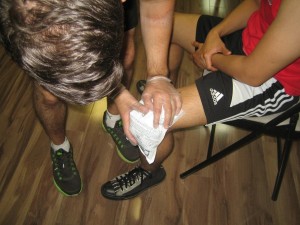Cryotherapy or cold therapy can provide a number of effects on the body right after injury and later in the rehabilitation process. This treatment option is commonly used in sporting injuries as the first line of management. As a commonly used treatment option, learning how to effectively provide one can greatly help out in case it is needed.
https://www.youtube.com/watch?v=9-xqY2QJLH8
Pain relief
It is still unclear on what is the exact reason behind ice application that results to pain relief. There are a number of theories and it is possible that various proposed mechanisms in combination can provide pain relief. Some of the possible mechanism includes the following:

- Diminished nerve transmission in the pain fibers
- Cold triggers the release of endorphins
- Cold reduces the activity of the free nerve endings
- Cold increases the pain threshold
- The cold sensations overpower the pain sensations
Minimize swelling and bleeding
By cooling the skin surface and the underlying tissues, the application of ice causes the constriction of the blood vessels which is called as vasoconstriction. This will lead to a decrease in the amount of bleed that is delivered to the injured area, thus reducing the amount of swelling that occurs.
After some time, the blood vessels dilate to allow blood to return to the area. This is followed by another phase of vasoconstriction. Even though blood still flows into the area, the amount of swelling is significantly reduced if ice was not applied. The reduced swelling will allow more movement in the muscle and lessens the functional loss linked with the injury.
In addition, the swelling linked with the inflammatory response will also cause an increase in the pressure in the tissue, thus causing the area to become painful. This pain is increased by certain chemicals released into the blood once the tissue is damage. Understandably, vasoconstriction caused by the ice will also reduce the pain.
Diminished muscle spasm
Muscle spasm is often a reaction to the pain. The muscles that surround the site of injury contract to protect it. This is called as muscle guarding and it aims to prevent further damage. The application of ice for pain relief is beneficial in minimizing the muscle spasms.
On the other hand, it is also believed that muscle spasms that are not caused by acute injury but due to overuse or imbalances can be reduced by using cold therapy. This is not yet fully understood but the application of ice is known to slow the conduction velocity of motor and sensory nerves as well as the activity of the muscle spindle cells that are responsible for muscle tone, resulting to diminished motor activity.
Reduced metabolic rate
By reducing the metabolic rate of the cells, the application of an ice pack will reduce the oxygen requirements of the cells. Once the flow of blood is reduced due to vasoconstriction, the risk of cell death due to oxygen demands is reduced.
